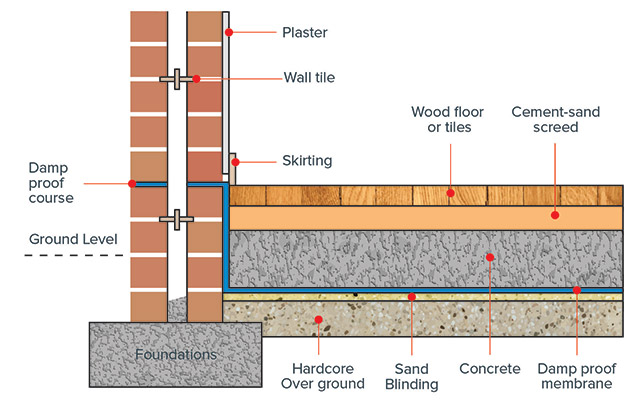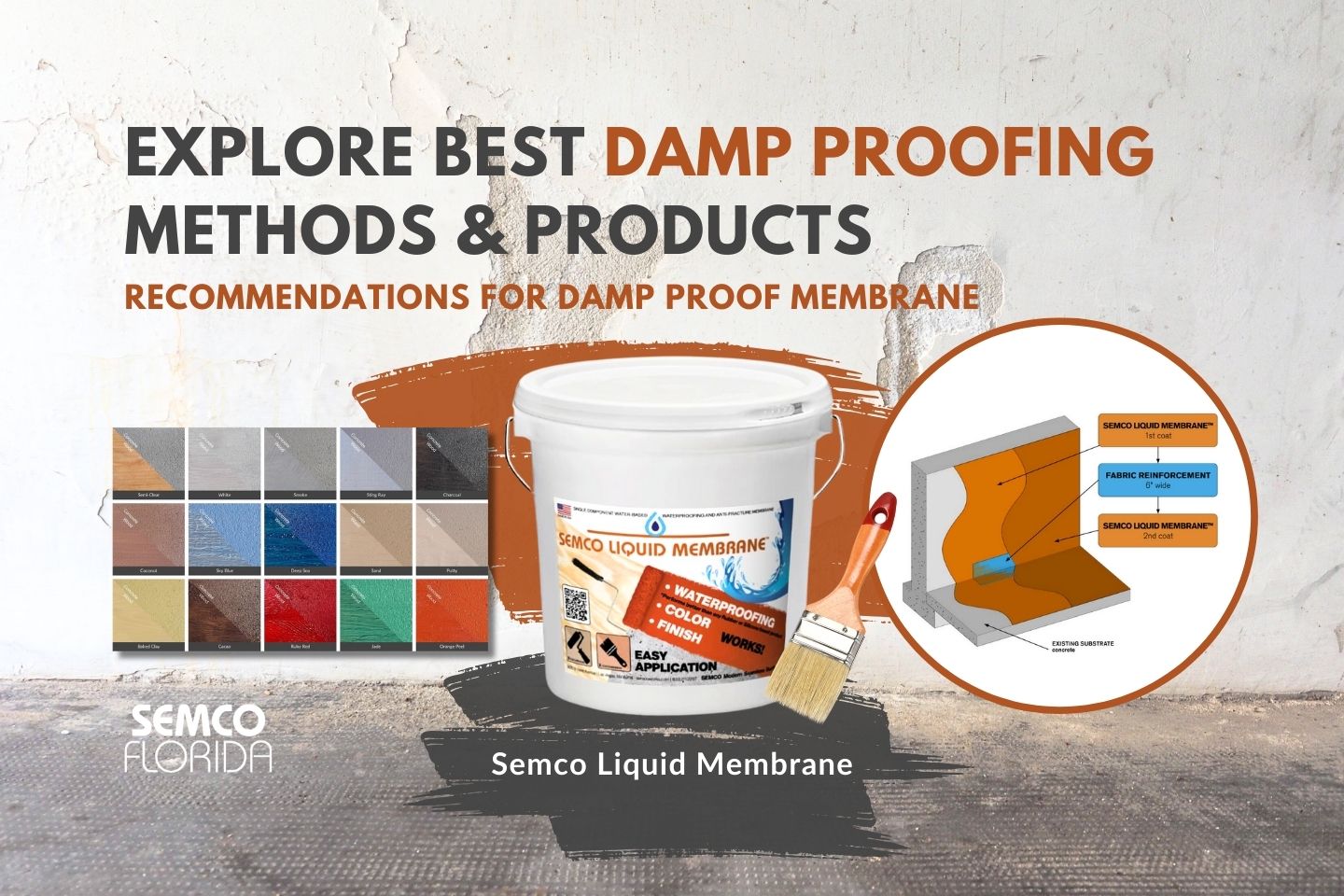Real reasons to hire a licensed damp specialist newcastle today
Real reasons to hire a licensed damp specialist newcastle today
Blog Article
Exploring the Various Methods and Solutions for Effective Damp Proofing
Moisture in buildings postures significant challenges to both structural stability and indoor air high quality. Different strategies and remedies have actually emerged to battle this prevalent issue. From conventional damp-proof membrane layers to cutting-edge chemical treatments, each method offers unique advantages. Understanding these options is crucial for effective wetness control. Selecting the appropriate service depends on specific building conditions and demands, triggering additional exploration into the most reliable moist proofing strategies available.
Understanding the Sources Of Dampness
Dampness can develop from different sources, understanding these reasons is essential for efficient remediation. Typically, dampness stems from three main resources: rising wet, penetrating wet, and condensation. Climbing wet happens when groundwater travels up-wards via porous products, such as block or rock, usually as a result of an absence of an efficient barrier (damp specialist newcastle). Permeating damp is typically brought on by external variables, including roof covering leaks, faulty seamless gutters, or damaged wall surfaces, enabling water to penetrate a property. Condensation, on the various other hand, arises from excess wetness airborne, commonly intensified by inadequate ventilation and temperature level differences, causing water droplets basing on surfaces. Determining these underlying issues is crucial, as each type of wetness needs a customized strategy for remediation. Proper evaluation helps in figuring out the most effective services, ultimately securing the structural integrity of a building and improving interior air top quality
Typical Damp-Proof Membranes

Chemical Damp-Proofing Solutions
Chemical damp-proofing services provide an ingenious technique to avoid moisture intrusion in buildings. These methods usually include the application of liquid chemicals that penetrate masonry and form an obstacle versus climbing wet. Generally made use of chemicals consist of silanes, siloxanes, and other water-repellent agents that react with surface area products to produce a hydrophobic layer.The application procedure typically needs drilling openings right into the wall surfaces, injecting the chemical solution, and permitting it to heal. This method is particularly advantageous for older frameworks where standard damp-proof membrane layers may be impractical. Additionally, chemical damp-proofing can be much less turbulent and a lot more economical than substantial remodelling projects.While reliable, these options depend upon proper application and ecological problems for peak performance. Routine maintenance and tracking are vital to ensure the long life of the damp-proofing treatment. On the whole, chemical damp-proofing stands for a functional option for protecting structures versus moisture-related damages
Cavity Wall Surface Building Strategies
Tooth cavity wall surface building and construction methods supply many advantages, particularly in dampness control and power effectiveness. By including an air void between 2 layers of stonework, these walls effectively alleviate water access while enhancing insulation. This combination not just protects frameworks from dampness but also adds to minimized energy usage.
Advantages of Cavity Walls
When thinking about effective damp proofing techniques, the advantages of dental caries walls stand apart plainly. Dental caries wall surfaces include two separate layers, producing an air gap that successfully minimizes moisture penetration. This design minimizes the risk of dampness, as the external wall works as an obstacle versus rainfall and water access. Furthermore, dental caries wall surfaces improve thermal insulation, which adds to energy efficiency by lowering heat loss. They additionally supply sound insulation, helping to create a quieter interior environment. The air void permits for air flow, which helps in wetness control and lowers the chance of mold and mildew growth. These benefits not only improve the overall convenience of a building but additionally add to its longevity and architectural stability.
Wetness Control Techniques
Efficient dampness control techniques are critical in tooth cavity wall building to guarantee long-lasting protection versus wetness. One main technique includes the unification of weep openings, which facilitate water drain from the cavity, avoiding buildup. Additionally, using breathable membrane layers can assist take care of wetness levels while permitting trapped vapor to run away. Proper placement of insulation is likewise vital, as it needs to not obstruct drain paths. Additionally, making sure that the outer fallen leaves of the cavity wall are created with water-resistant products improves overall longevity. Routine upkeep checks are necessary to recognize any clogs or damage early, safeguarding the structure's integrity. Ultimately, a combination of these techniques forms a robust defense against moisture invasion in tooth cavity walls.
Insulation and Energy Efficiency
Insulation plays an important role in enhancing energy efficiency within cavity wall building and construction. By including shielding products, these wall surfaces develop a thermal barrier that reduces warm loss and decreases energy intake. Reliable insulation not just aids keep a stable interior temperature level yet also reduces the danger of wetness, as it protects against condensation within the wall surface tooth cavity. Various strategies, such as the usage of stiff foam boards or mineral wool, can be used to attain suitable insulation performance. Additionally, correct setup is vital to ensure that gaps and gaps are decreased, which can or else jeopardize energy effectiveness. Ultimately, a well-insulated dental caries wall adds substantially to total sustainability and reduces heating & cooling expenses for property owners.
External Damp Proofing Approaches
Outside damp proofing techniques are vital for protecting frameworks from wetness infiltration. 2 effective methods include the application of water-proof membrane layers and the setup of French drains. These options help alleviate water build-up and protect the stability of structures.
Waterproof Membrane Layer Application
While numerous techniques exist for avoiding dampness access, the application of water-proof membranes continues to be a highly efficient external moist proofing technique. These membranes are typically made from materials such as polyethylene, rubber, or customized asphalt, giving a durable barrier versus water penetration. The installment process includes applying the membrane layer to the external surfaces of walls or foundations, guaranteeing total insurance coverage to avoid leaks. Appropriate attachment and securing at joints are crucial to optimizing effectiveness. Waterproof membranes can be applied in numerous forms, consisting of liquid finishings and sheet membrane layers, enabling versatility based upon the details demands of the structure. This method not only shields structures from wetness but also enhances their durability and structural stability.
French Drainpipe Setup
One efficient technique for managing groundwater and avoiding moisture build-up around a building's foundation is the installation of a French drainpipe. This water drainage system contains a trench loaded with crushed rock and a perforated pipe that redirects surface water far from the foundation. Appropriate installment calls for mindful planning, guaranteeing that the drain slopes far from the framework to facilitate optimal water flow. In addition, the area of the drain is important; it should be placed in locations prone to merging or excess wetness. Regular upkeep, including clearing up debris from the gravel and ensuring the pipe remains unhampered, is important for long-term performance. Inevitably, a well-installed French drain can significantly reduce the danger of water-related problems in foundations and cellars.
Interior Waterproofing Strategies
Inside waterproofing techniques are vital for shielding a building's interior from moisture infiltration and prospective water damage. These methods typically include the application of specific materials and techniques developed to develop a moisture barrier within the framework. One common strategy is using waterproof layers or sealants on walls and floorings, which prevent dampness from penetrating surfaces.Additionally, setting up interior drain systems, such as sump pumps, can efficiently manage water buildup in cellars and crawl spaces. One more approach involves using vapor obstacles, which are installed to prevent moisture motion from the ground right into living spaces.Moreover, dealing with any kind of here fractures or voids in walls or structures with ideal sealers assures a detailed protection versus water intrusion. By executing these interior waterproofing approaches, home proprietors can greatly reduce the danger of mold growth, structural damage, and other moisture-related issues. Proper execution of these strategies is important for long-lasting defense and structure honesty.
Normal Upkeep and Evaluation Practices
Routine maintenance and assessment methods are crucial for assuring the long-term effectiveness of moist proofing services in any kind of building. Routine checks make it possible for building owners to recognize very early indicators of dampness invasion, such as peeling paint, mold growth, and moldy odors. These indications can signal underlying concerns that require instant attention.Inspections need to be performed a minimum of each year, concentrating on susceptible locations like basements, crawl rooms, and outside wall surfaces. During these assessments, homeowner must analyze sealers, water drainage systems, and ventilation to confirm they work correctly.Additionally, maintaining downspouts and rain gutters is vital, as clogged systems can cause water accumulation near the structure. Executing a normal maintenance schedule, in addition to timely repairs, can considerably extend the life expectancy of moist proofing actions and shield the architectural honesty of the building. Aggressive steps ultimately add to the overall health and safety and security of the living atmosphere.
Frequently Asked Inquiries
The Length Of Time Does Damp Proofing Generally Last?
The duration of wet proofing performance differs, usually lasting between 20 to half a century. Factors such as application high quality, ecological conditions, and upkeep methods substantially affect the durability of the damp proofing treatment.

Can I Damp Evidence My Home Myself?
The individual pondered the feasibility of do it yourself damp proofing. With proper study and the right products, it is feasible. Nonetheless, they additionally recognized the importance of specialist guidance to ensure long-lasting effectiveness and avoid future issues.
What Are the Signs of Inadequate Damp Proofing?
Indicators of ineffective moist proofing consist of relentless musty smells, noticeable mold and mildew development, peeling off paint, moist patches on wall surfaces, and timber degeneration - damp proofing newcastle. Homeowners must deal with these issues immediately to stop additional damage and wellness problems
Does Damp Proofing Affect Indoor Air Quality?

Just How Much Does Specialist Damp Proofing Price?
Professional moist proofing costs differ considerably, commonly ranging from $1,000 to $5,000 relying on the home's size, the degree of the wet concern, and picked approaches. Each scenario needs a tailored assessment for exact pricing. Typically, moisture stems from three main resources: increasing wet, permeating damp, and condensation. When considering effective wet proofing methods, the advantages of tooth cavity walls stand out prominently. Exterior wet proofing methods are crucial for shielding frameworks from wetness seepage. While various approaches exist for protecting against dampness ingress, the application of water-proof membranes stays a very reliable exterior moist proofing technique. Signs of inadequate damp proofing include consistent mildewy smells, noticeable mold development, peeling off paint, damp patches on walls, and wood decay.
Report this page